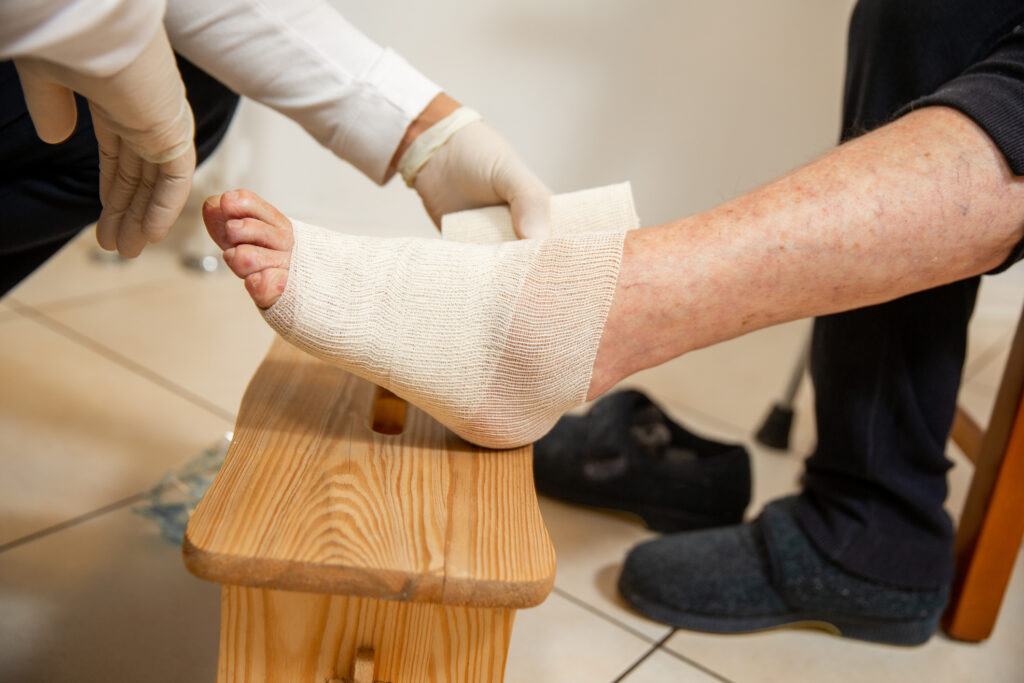Diabetic foot wounds present a major challenge for many individuals managing diabetes. Complications from these wounds, such as infections and tissue damage, demand specialized care to avoid severe outcomes like amputations or long-term mobility issues. This article explores the importance of Orthopedic Treatment for Diabetic Foot Wound Care, delving into how advanced techniques can manage infections, preserve tissue, and restore mobility, ultimately improving quality of life.
Understanding Diabetic Foot Wounds
Diabetic foot wounds are a common complication arising from diabetes. They occur when even minor injuries, cuts, or blisters fail to heal properly due to the underlying effects of diabetes on circulation and nerve function. Poor blood flow (peripheral vascular disease) and diabetic neuropathy are two major factors that contribute to the formation and deterioration of these wounds. Nerve damage reduces sensation, meaning that many patients may not immediately notice an injury, while reduced circulation limits the body’s natural healing processes.
Diabetic foot wounds require early detection and specialized care, because when left untreated, they can rapidly develop into more serious problems. Understanding the multifaceted nature of these wounds is the first step toward effective management and prevention of further complications.
Complications of Untreated Diabetic Foot Wounds
Without prompt and specialized treatment, diabetic foot wounds can escalate into several severe complications:
- Infections: The compromised immune response in diabetic patients increases the risk of local infections spreading into deeper tissues. Once bacteria infiltrate, the wound can become infected, sometimes leading to systemic infections (sepsis).
- Tissue Necrosis: Poor circulation can result in tissue death (necrosis). This significantly reduces the body’s ability to combat infections and repair itself, potentially resulting in an irreversible loss of tissue.
- Amputation: In severe cases, when infections or tissue necrosis become unmanageable, the risk of amputation becomes high. This not only affects mobility but also significantly diminishes overall quality of life.
- Chronic Pain and Reduced Mobility: Ongoing wound issues can lead to chronic pain and reduced function in the affected limb, impacting daily activities and independence.
Recognizing these risks emphasizes why Orthopedic Treatment for Diabetic Foot Wound Care is crucial in managing and mitigating these dangers.
The Role of Orthopedic Treatment in Diabetic Foot Wound Care
Orthopedic specialists play an essential role in managing diabetic foot wounds. Their focus on a multidisciplinary approach ensures that various aspects of wound care—from infection management to restoring mobility—are addressed comprehensively. This specialized care is designed to halt the progression of the wound, preserve healthy tissue, and support overall functional recovery.
How Orthopedic Treatment Benefits Diabetic Foot Wound Healing
Orthopedic Treatment for Diabetic Foot Wound Care is designed to integrate several treatment modalities to tackle the complexity of diabetic wounds. By targeting specific aspects of wound management, these treatments work synergistically to:
- Prevent the progression of wounds to more severe stages.
- Control and manage infections before they become systemic.
- Promote the preservation of healthy tissues around the wound.
- Enhance mobility and prevent further complications through structured rehabilitation programs.
Each treatment is often tailored to an individual’s unique clinical profile, ensuring that patients receive personalized care that addresses their specific needs and risks.
Infection Management
One of the primary goals of orthopedic treatment in diabetic foot wound care is to control and eliminate infection. Diabetic wounds are particularly susceptible to bacterial invasion due to impaired immune function and reduced blood circulation. Orthopedic strategies include:
- Debridement: This procedure involves the careful removal of dead or infected tissue to prevent the spread of infection and stimulate the healing process.
- Antibiotic Therapy: Tailored antibiotic regimens are administered based on the type of bacteria found in the wound. This can involve both systemic antibiotics and localized antibiotic delivery systems.
- Advanced Wound Dressings: Innovative dressings that incorporate antimicrobial agents or promote a moist healing environment can help reduce the bacterial load on the wound surface.
Maintaining stringent infection control measures is paramount to ensure that the wound can heal successfully, and the patient can regain mobility without the risk of recurrent infections.
Tissue Preservation Techniques
Preservation of healthy tissue during the treatment process is as important as eliminating the infection. Tissue preservation strategies focus on:
- Minimally Invasive Procedures: Techniques that reduce tissue damage while removing only the necrotic or infected areas can help retain as much healthy tissue as possible.
- Adjunct Therapies: These may include hyperbaric oxygen therapy, which increases oxygen delivery to the affected tissues, thereby enhancing healing and tissue regeneration.
- Innovative Biologic Dressings: The use of skin substitutes or growth factor-enhanced dressings supports tissue regeneration, providing a scaffold that encourages natural healing processes.
By preserving viable tissue, orthopedic treatment not only helps the wound heal more efficiently but also reduces the risk of recurrence and promotes better long-term outcomes.
Improving Mobility and Preventing Further Complications
Achieving and maintaining mobility is a critical component of diabetic foot wound care. Immobility not only complicates the healing process but also significantly diminishes a patient’s quality of life. Orthopedic treatment addresses mobility challenges in several ways:
- Rehabilitation Programs: Structured physical therapy and rehabilitation exercises help restore strength and function in the affected limb. These programs are designed to gradually improve weight-bearing capacity and enhance balance.
- Assistive Devices: When necessary, orthopedic specialists recommend the use of braces, custom orthotics, or specialized footwear. These devices provide support, reduce undue pressure on the healing wound, and improve overall mobility.
- Patient Education: Training patients in proper foot care and injury prevention can significantly reduce the chances of re-injury. Knowledge about recognizing early signs of complications and the importance of regular check-ups is vital for maintaining mobility and health.
By integrating mobility enhancement into the overall treatment strategy, patients experience not only faster wound healing but also a notable improvement in their ability to perform daily activities.
Advanced Treatment Approaches at Tec Orthopedics
At Tec Orthopedics, the specialized approach to Orthopedic Treatment for Diabetic Foot Wound Care leverages both innovative technologies and personalized care strategies. The comprehensive treatment plans incorporate state-of-the-art procedures and a multidisciplinary team approach.
Our Specialized Approach to Diabetic Foot Wound Care
Tec Orthopedics is committed to providing cutting-edge care for patients with diabetic foot wounds. Their approach includes:
- Innovative Technologies: Utilization of advanced wound care devices such as negative pressure wound therapy (NPWT) that create controlled environments to promote healing.
- Multidisciplinary Collaboration: Coordination with endocrinologists, podiatrists, and wound care specialists to create cohesive treatment plans. This collaborative approach ensures that all aspects of the patient’s health are considered.
- Patient-Centered Care: Customized treatment plans that are tailored to each patient’s specific condition, ensuring optimal outcomes.
Personalized Treatment Plans
Each patient is unique, and so is their wound care journey. At Tec Orthopedics, personalized treatment plans are developed following thorough assessments, which include:
- Detailed medical history and diabetes management evaluation.
- Comprehensive imaging and wound assessment.
- Customized combination of surgical and non-surgical interventions tailored to the patient’s needs.
Personalization ensures that the orthopedic treatment not only addresses the current wound but also anticipates and mitigates potential future complications, thereby supporting long-term health and mobility.
Patient Education and Self-Care
Empowering patients with the knowledge and tools to manage their condition is a pivotal component of successful diabetic foot wound care. Educated patients are better equipped to prevent further complications and take proactive measures to protect their health.
Home Care Tips for Diabetic Foot Wound Management
For many patients, learning proper home care routines can significantly influence the healing trajectory. Some essential tips include:
- Daily Foot Hygiene: Wash and carefully inspect your feet daily. Ensure that any cuts, blisters, or abrasions are promptly cleaned and monitored.
- Moisturization: Use appropriate moisturizers to maintain skin integrity while avoiding excessive moisture that could promote fungal infections.
- Proper Footwear: Invest in well-fitting shoes and specialized diabetic footwear that alleviate undue pressure on the feet and prevent friction injuries.
- Regular Monitoring: Keep track of any changes in the wound’s appearance or new discomfort, and maintain regular contact with your healthcare provider.
By integrating these practices into daily life, patients can significantly reduce the risk of wound progression and improve overall healing outcomes.
The Role of Regular Check-Ups
Regular check-ups with orthopedic specialists are integral to successful diabetic foot wound management. These visits provide:
- Early Detection: Continuous monitoring allows for early detection of any complications, so that interventions can be made before a minor issue escalates.
- Treatment Adjustments: As the patient’s condition evolves, follow-up appointments enable healthcare providers to adjust treatment plans to better suit the healing process.
- Reinforcement of Self-Care Practices: Healthcare professionals can offer ongoing advice and education on proper foot care, ensuring that patients stay informed about best practices and emerging treatment options.
Taking Control of Diabetic Foot Wound Care with Expert Orthopedic Treatment
Understanding the underlying causes and potential complications of diabetic foot wounds empowers patients and caregivers to take proactive steps towards healing. Orthopedic Treatment for Diabetic Foot Wound Care offers not only a path to effective wound management but also improved quality of life through enhanced mobility and reduced complications.
The multi-pronged approach of infection management, tissue preservation, and mobility restoration is critical in ensuring long-term patient health. Through both innovative techniques and dedicated patient education, orthopedic specialists provide the support needed to navigate this challenging aspect of diabetes management.
Ready to Improve Your Diabetic Foot Health?
If you or a loved one is struggling with diabetic foot wounds, early intervention is key. Consulting with an orthopedic specialist can make all the difference. At Tec Orthopedics, our experienced team is dedicated to offering individualized treatment plans designed to manage infections, preserve tissue, and restore mobility. Don’t let diabetic foot wounds dictate your quality of life—schedule a consultation today to take the first step towards recovery.
For further information or to arrange an appointment, please visit our website or contact our office. Empower yourself with expert care and join the many patients who have successfully managed their condition through specialized orthopedic treatment.
Additional Resources and Further Reading
- Related Articles: Check out our blog posts on the latest advancements in diabetic wound care and comprehensive foot care strategies.
- Patient Guides: Download our free guide on maintaining optimal foot health when living with diabetes.
- Medical Research: Visit reputable organizations such as the American Diabetes Association and the National Institute of Diabetes and Digestive and Kidney Diseases for additional insights and resources.
- Community Support: Connect with local support groups that provide education and resources for managing diabetic complications.
Takeaway
Effective management of diabetic foot wounds through Orthopedic Treatment for Diabetic Foot Wound Care is essential for preventing severe complications, such as infections, tissue necrosis, and even amputations. By integrating targeted infection management, tissue preservation techniques, and rehabilitation programs to enhance mobility, orthopedic specialists can offer a comprehensive solution that not only facilitates wound healing but also significantly improves quality of life.
This patient-centered, multidisciplinary approach emphasizes early intervention and personalized treatment plans, ensuring that each individual receives care tailored to their unique needs. With ongoing education, regular check-ups, and proactive self-care strategies, patients are empowered to manage their condition and take vital steps to safeguard their future well-being.
Embracing these innovative treatment options leads to better healing outcomes and a reduction in complications associated with diabetic foot wounds. Ultimately, expert orthopedic treatment serves as a critical ally in the fight against the debilitating effects of diabetic complications, paving the way for improved health, enhanced mobility, and a more active, fulfilling life.




